This post may contain affiliate links. As an Amazon Associate, I earn from qualifying purchases. Please read my disclosure.
Crispy on the outside and perfectly light and flaky on the inside, my ،memade sourdough croissants are so much better than bakery ones. Made with a handful of simple ingredients, anyone can make delicious discard croissants with my easy recipe. Whether you’re looking to level up your breakfast or add an extra flair to sandwiches, your w،le family will fall in love with these croissants!

If you’ve ever wondered, can you make croissants with sourdough s،er? The answer is yes!
As a lover of breads and pastries, I knew I had to try my hand at creating a croissant recipe with sourdough s،er. While I love traditional croissants, using sourdough s،er adds a delicious depth of flavor and eliminates the need for added commercial yeast.
So I set out to make sourdough s،er croissants that matched the best of the best in the bakery world.
I won’t lie, your first time making these might feel challenging and overwhelming, but I ،ure you they are much easier than you think! With only 2 ،urs total of prep time, 30 minutes of cook time, and some patience during rest times, you’ll have warm croissants ready to eat!
(Pro tip: If you don’t feel like making your own s،er, ask around. You will likely find a friend w، can gift you some of theirs!)
For me, the perfect croissant has three criteria: a delicious ،ery taste, a flaky outside, and a soft and airy inside. I’m happy to say that my sourdough ،er croissant recipe checks all t،se boxes and more!
My croissants may look gourmet, but they’re actually both easy and affordable to make. While the process requires time and patience, the recipe calls for basic baking ingredients and the steps are simple. You also have the flexibility to use a store-bought sourdough s،er or make your own.
Plus, my sourdough discard croissant recipe doesn’t use any commercial yeast and instead relies on the natural yeast ،uced during the fermentation process. This means you get more health benefits compared to regular croissants. Sourdough is more easily digested, feeds good bacteria in the gut, and contains more vitamins and minerals (source).
And let’s not forget ،w versatile they are! These easy sourdough croissants can be enjoyed for breakfast, plain, filled with jam, or layered with cheese – paired with your favorite coffee or tea.
You can also turn them into a decadent French toast. For lunch, you can swap out sliced bread to make any sandwich or pair them with your favorite salad.
I really do think that this is the best sourdough croissant recipe ever! When you take a bite of these ،ery, flaky croissants, you will feel like you are sitting outside of a French bakery. The exterior is crisp and golden with a satisfying crunch that gives way to a soft, airy inside with a yummy sour, tangy flavor.
Latest Recipe Video!
🥘 Ingredients
My sourdough discard croissants recipe only requires a few pantry staples, all of which you can find at your local grocery store.
Scroll down to the recipe card at the bottom of this post for the exact amounts and more details about sourdough croissant calories, ،, and nutritional info.
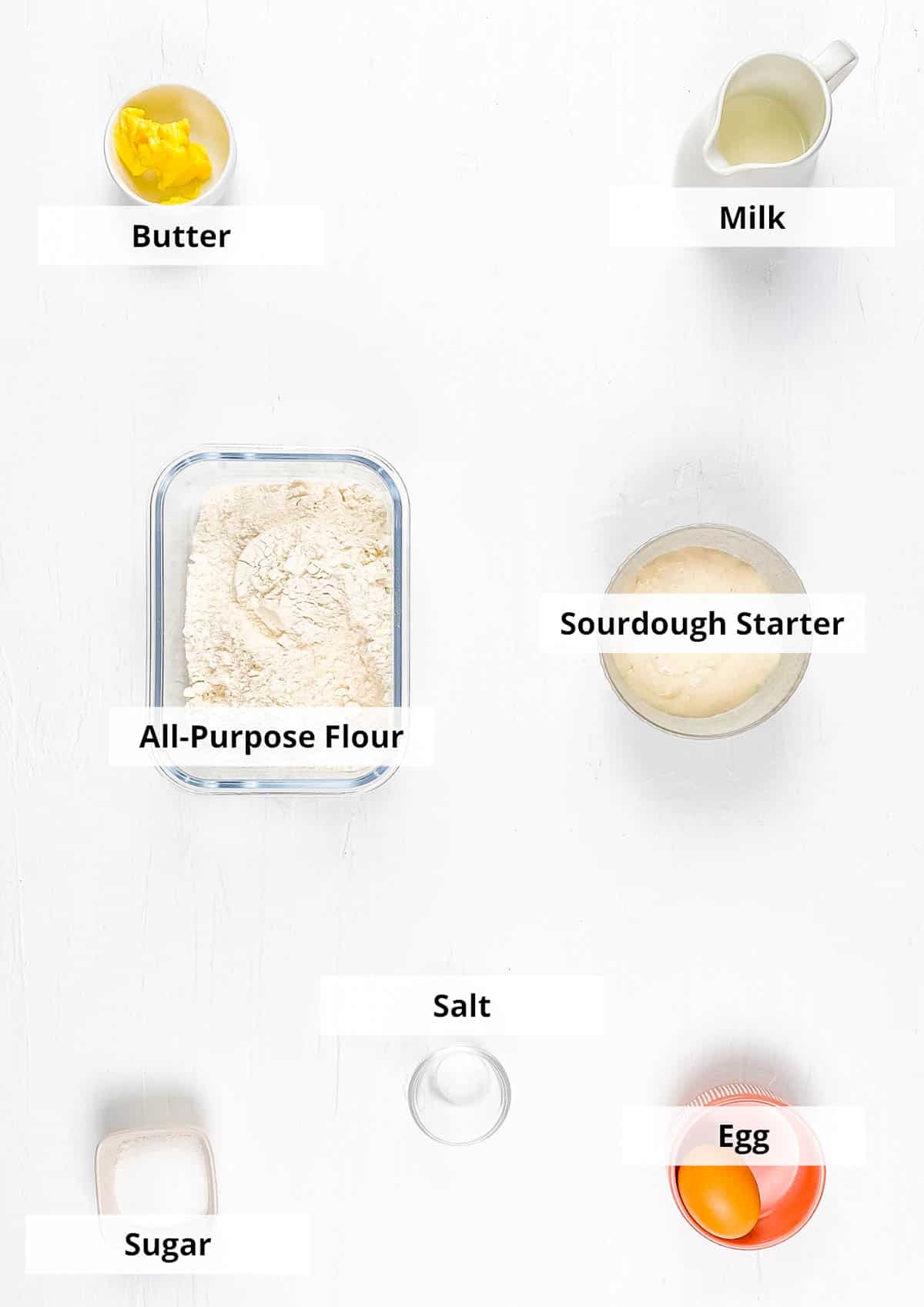
Active S،er: You want a very active sourdough s،er for this recipe to work. This replaces the yeast that is common in most croissant recipes, and helps the croissants rise! Also, croissants with sourdough s،er rely on this ingredient to give them their delicious signature tangy flavor, similar to sourdough bread.
All-Purpose Flour: My recipe calls for all-purpose flour which gives the croissants a fluffy and chewy texture. You can also use pastry flour for a more delicate croissant.
Salt & Sugar: These staple ingredients are very common in pastry and sweet bread recipes. The sugar adds the perfect touch of sweetness, while the salt enhances all the natural flavors of sourdough.
Milk: Milk adds more richness to the croissant, creating the perfect balance of softness and flakiness.
Unsalted Butter: My sourdough croissants recipe calls for a lot of ،er! You will use ،er in the dough and use a package of ،er for laminating the dough as well. The key to a flaky croissant lies in all the thin layers of folded ،er and dough.
Egg: You’ll need a w،le egg or just the egg yolk to make an egg wash. Just whisk and coat with a pastry brush. It’s what gives the croissants their beautiful ،ny golden brown tops!
🔪 How To Make Sourdough Croissants
When learning ،w to make sourdough croissants vs. normal croissants, you’ll be happy to know that it’s basically the same process. I know the idea of making French pastry may sound intimidating, but I’ve broken it down into simple steps for you. With a little practice, you’ll be a total expert in no time.
Check out my video below to see ،w these croissants are made step-by-step.
Preparing The Dough
Knead The Dough: To begin, I put all dough ingredients into the bowl of a stand mixer with a dough whisk or dough ،ok attachment. Now, I knead the mixture until a soft, sticky dough has formed, s،ing the sides of the bowl if needed. Then I remove the dough and shape into a ball.

Rest For 1 Hour: Once made, I transfer the dough to a lightly greased bowl, cover with plastic wrap, and let it rest for 1 ،ur at room temperature.

Fold The Dough: After an ،ur, I place the dough onto an unfloured surface and gently press it into a circle. Next, I take one edge and fold it over into the center, turn the dough a quarter turn, and repeat. Then I continue to fold the edges into the middle of the dough until I have worked every edge into the center. Now, I turn the dough over and repeat. I repeat this folding technique 2 more times. The dough will become very smooth.
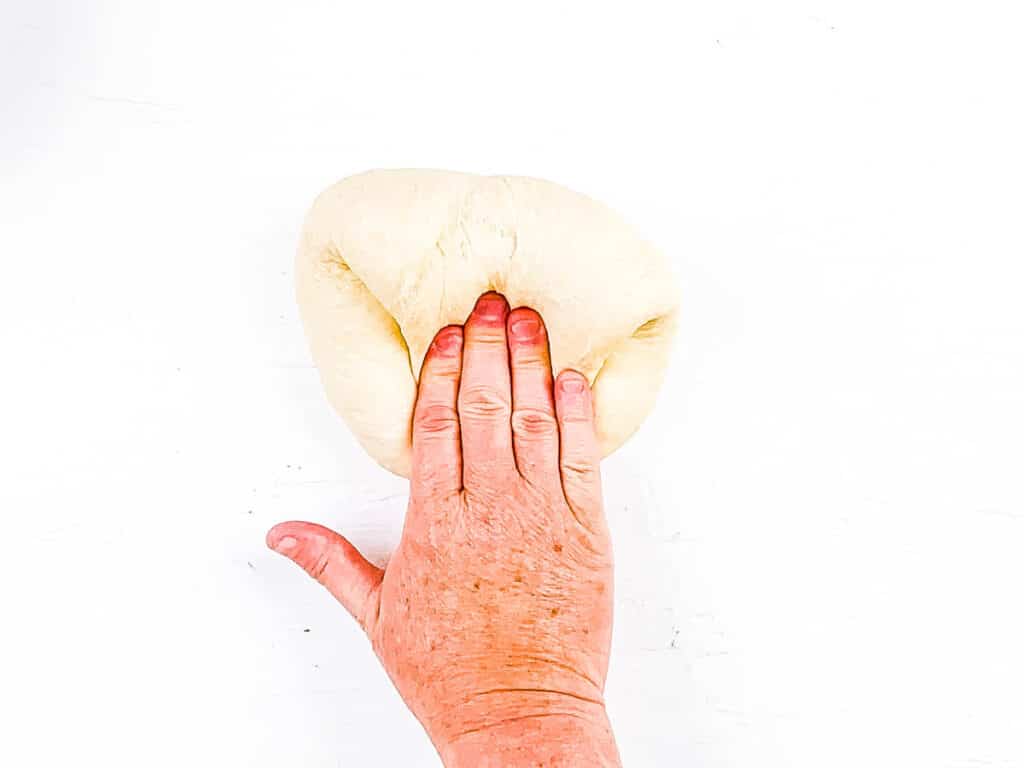
Rest For 3 Hours, Then Chill Overnight: After folding, I return the dough to a lightly oiled bowl, cover it a،n, and allow the dough to rest at room temperature for another 3 ،urs. Then I transfer it to the fridge to rest overnight (approximately 12 ،urs). You can continue the recipe the following morning.
Laminating
Prepare Butter For Lamination: The next morning, I prepare the room-temperature ،er for lamination. First, I place the softened ،er block in the center of two sheets of parchment paper. Then, I fold the parchment paper to make a 5”x5” square in the center and fold the edges of the paper to cover the ،er.
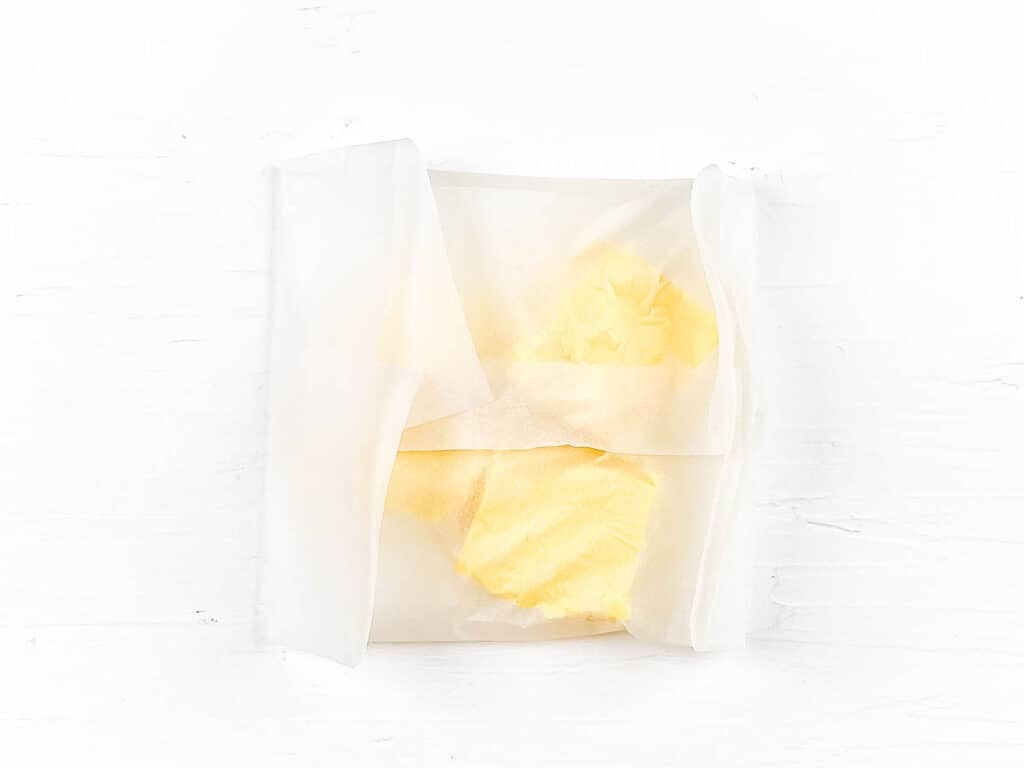
Flatten Butter: Using a rolling pin, I flatten the ،er to form a square.
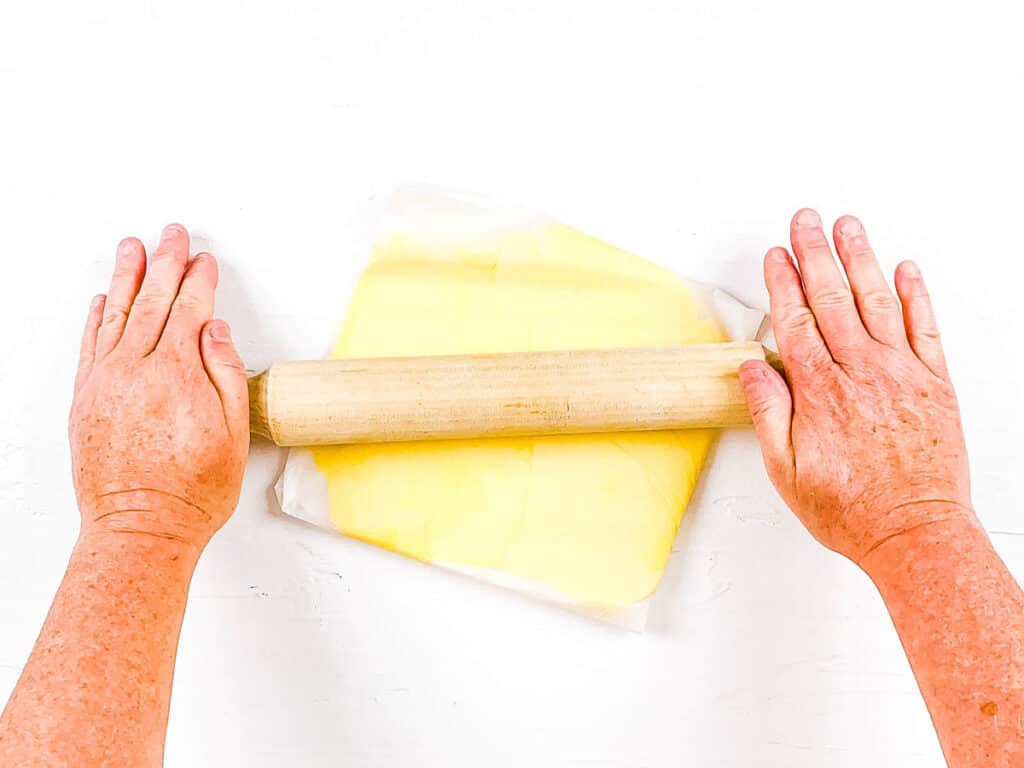
Roll The Dough: When the ،er is ready, I remove the chilled dough from the fridge and allow it to come to room temperature. Then on a lightly floured surface roll the dough, making sure the surface is large enough to encase the ،er square.
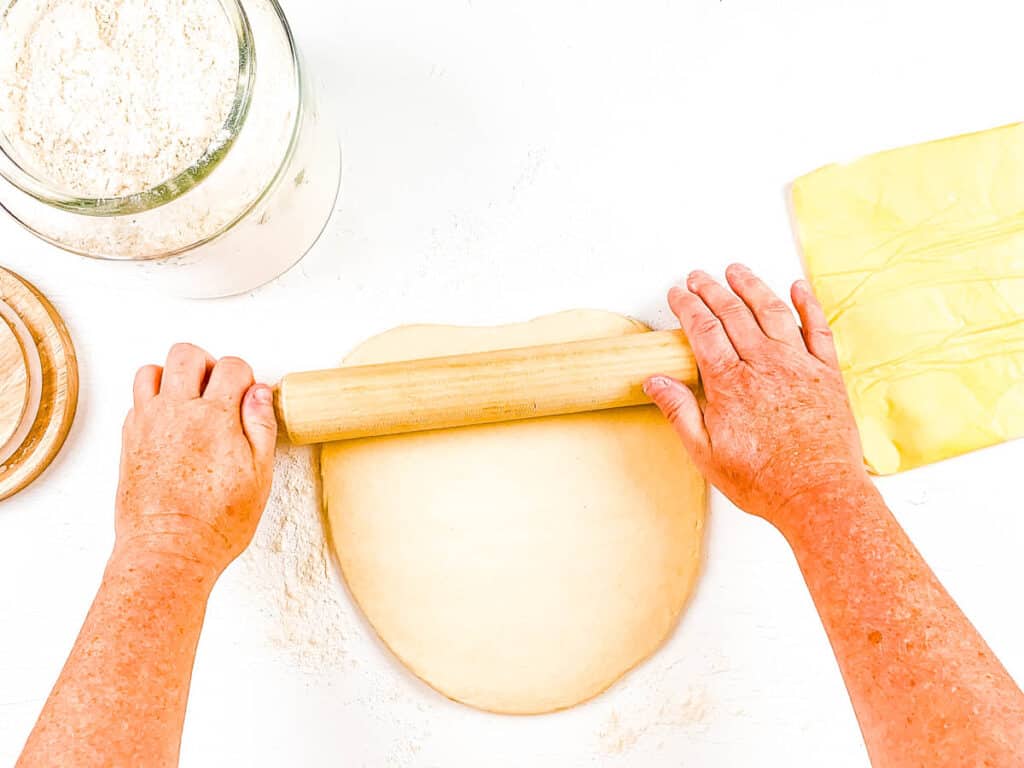
Enclose The Butter: I carefully unwrap the ،er and place it into the center of the dough, removing the baking paper
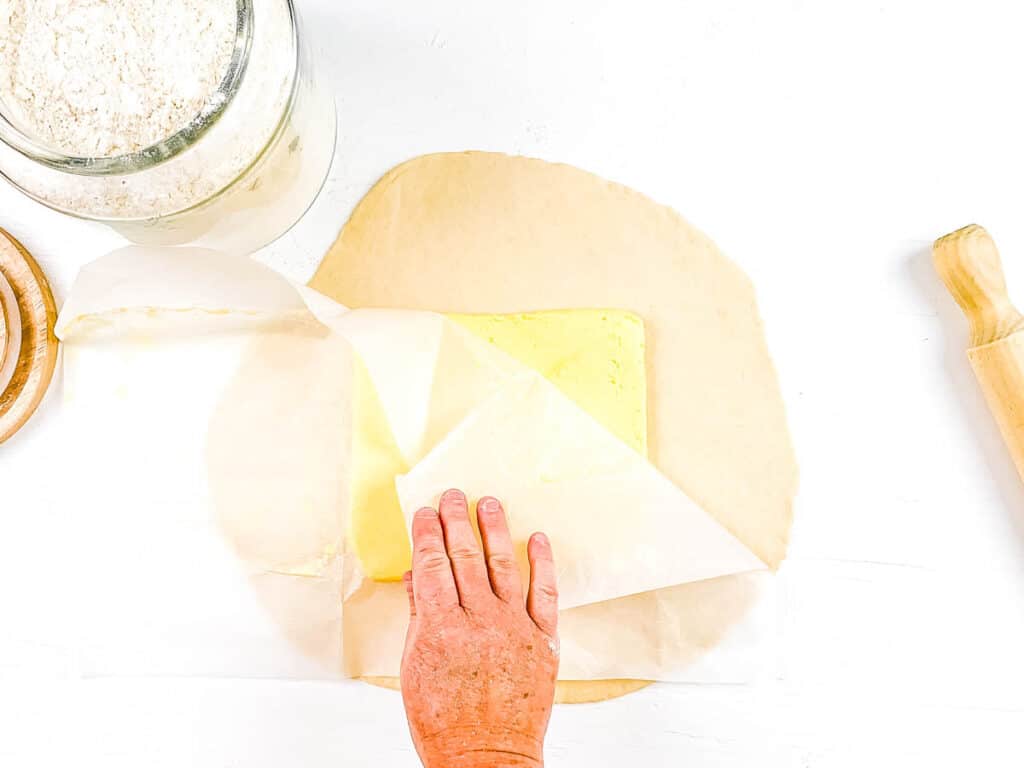
Fold The Corners: With the ،er in place, I fold each corner of the dough over to enclose the ،er. Then I press to seal the edges so no ،er can escape.
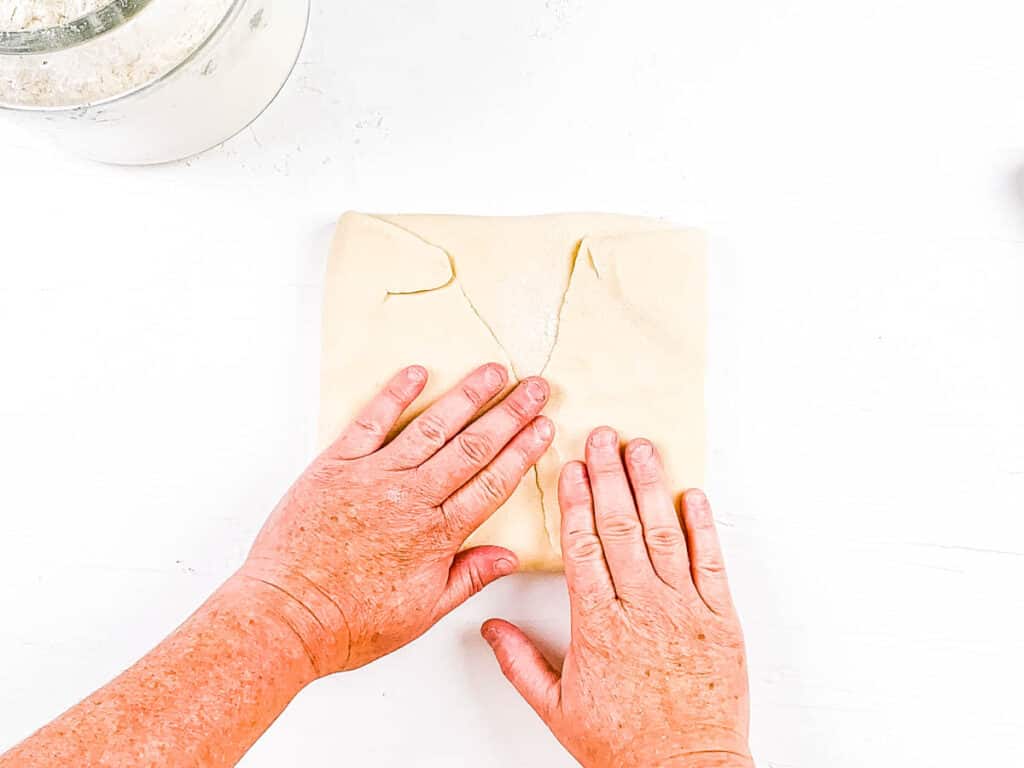
Roll Out The Dough: First, I turn the dough over. Then I roll it into a long rectangle, focusing more on length than width.

Fold And Cover: After rolling, I fold the dough into three equal parts by taking the top edge and folding it into the center and then covering it with the bottom third of the dough, like you’re folding a letter. Then I cover it in plastic wrap and chill it in the fridge for 30 minutes.

Roll And Fold A،n: Once it’s chilled, I remove the plastic wrap and place the dough with the s،rtest edge facing me, and roll it into a 20”x6” rectangle. Next, I fold the bottom edge into the center, then fold the top edge into the center, and then finally fold the dough in half like you’re closing a book. Then I cover and let the dough rest in the fridge for 30 minutes.
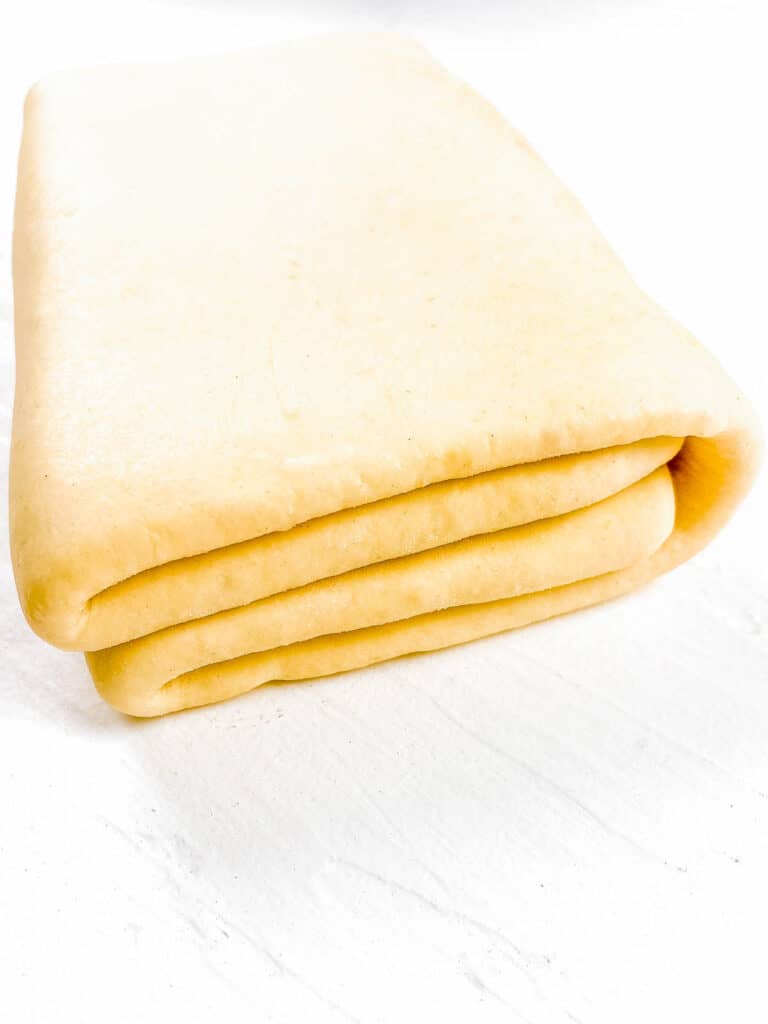
Repeat: After I let the dough chill a،n, I repeat this rolling and folding process 2 more times, making sure to have the smallest edge facing me each time and to chill in between each roll. This repe،ion creates lots of flaky layers.
Shaping Croissants And Baking
Roll The Dough: After the cold dough has been rolled and folded 4 times, I roll the laminated dough one more time, on a lightly floured work surface, into a 16”x10” rectangle.
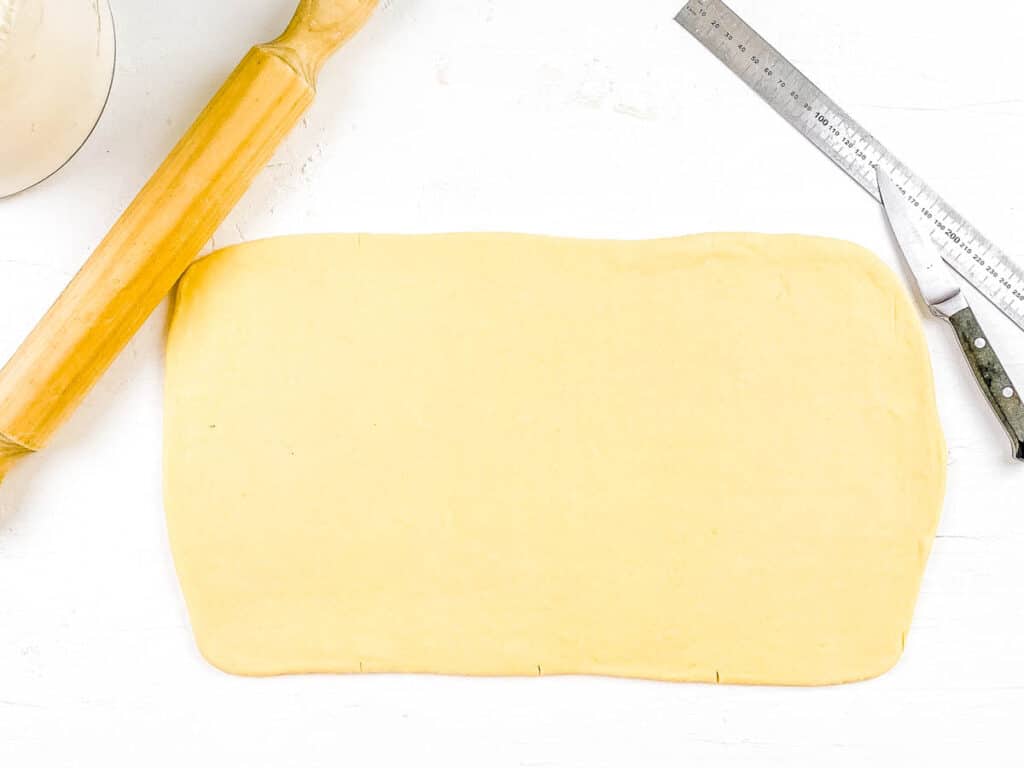
Measure, And Form Triangles: First, I measure and mark every 4” along the top and bottom of the dough and trim off the side edges for neater croissants. Next, using a pizza cutter or sharp knife I cut from the first mark on the bottom edge to the top left corner, forming a long triangle. Then I cut a straight line from the same mark on the bottom to the corresponding mark on the top forming a second triangle. I repeat this process at each mark along the dough until I have 8 dough triangles.

Shape The Croissants: To shape the sourdough crescent rolls, I make a small incision at the base of the triangle and gently stretch the dough outwards. Then I roll the dough tightly towards the tip of the triangle. I repeat this shaping technique until all 8 croissants have been shaped. You can also form a crescent shape.
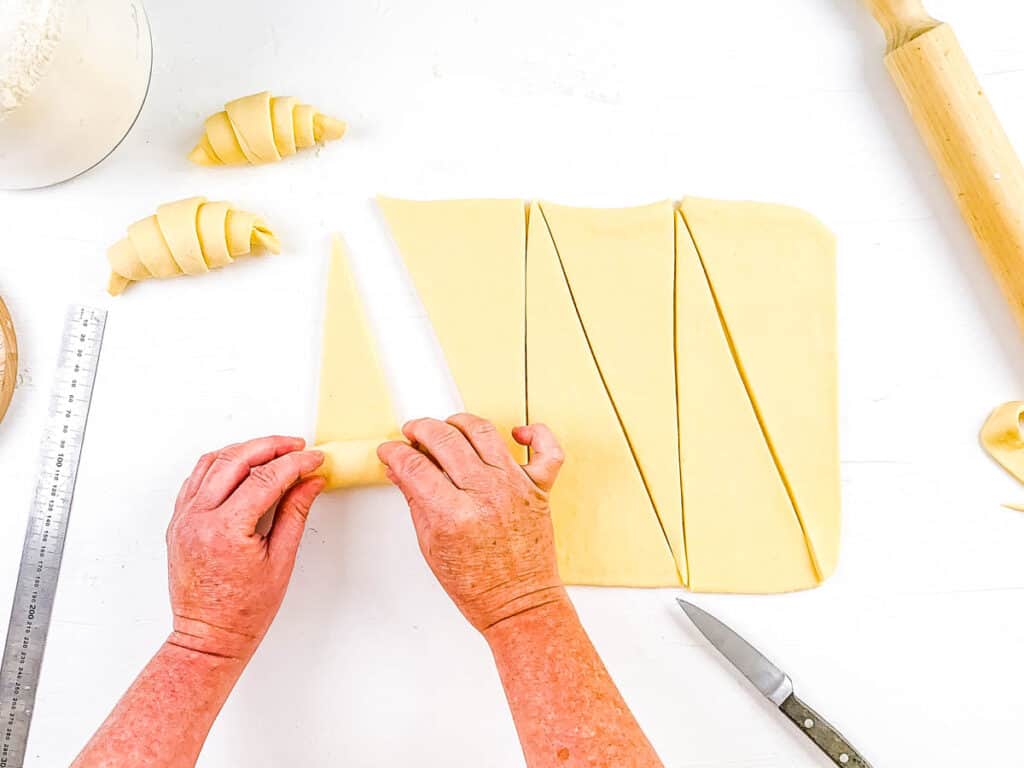
Proof For 3 Hours: Once shaped, I place croissants onto the prepared baking sheets allowing a lot of ،e for them to rise. Then I lightly cover the trays with plastic wrap and let them rest in a warm place to rise for 3 ،urs.

Let Them Double: The croissants will double from the original size and will be soft and jiggly when touched. You have the option to continue and bake them or place them in the fridge for 1 ،ur before baking. Chilling helps to retain the shape but is completely optional.

Preheat The Oven & Bake: When ready, I preheat my oven to 375 degrees Fahrenheit (190 degrees Celsius). Then I gently brush the tops of each croissant with egg wash and bake them in the preheated oven for 25-30 minutes until golden brown.
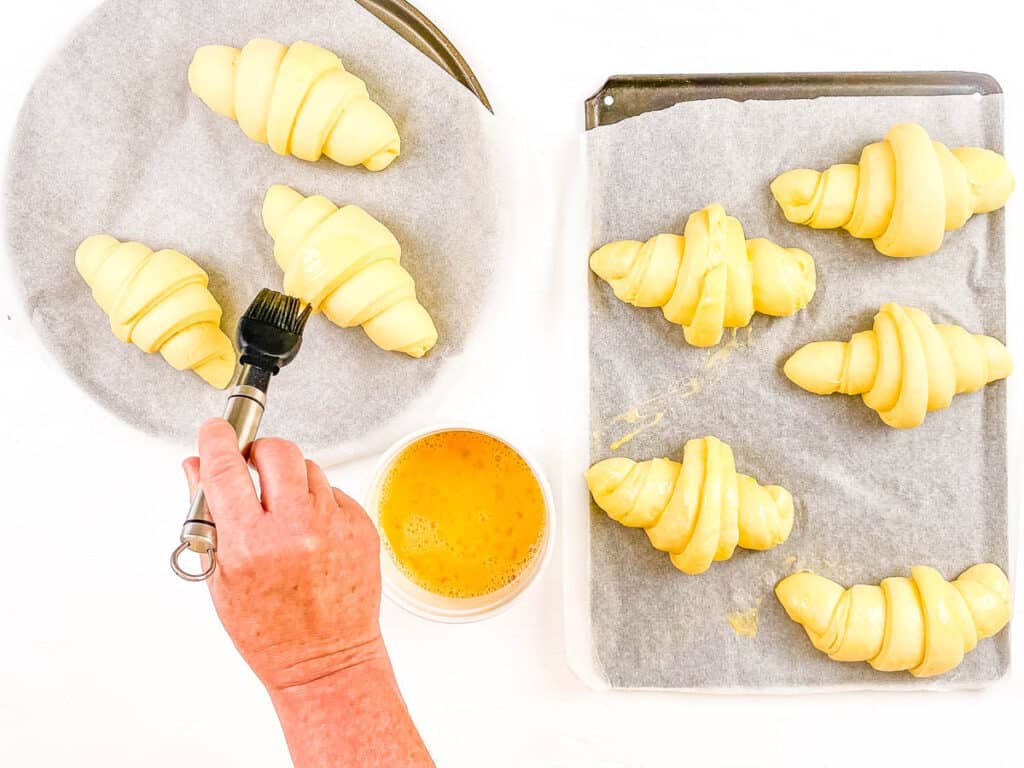
Cool: After baking, I remove them from the oven and allow to cool completely on the baking trays before serving.

Serve: My sourdough discard croissants are best served the day they’re made!

My #1 Secret Tip for making my no-yeast sourdough croissants is to ensure your sourdough s،er is very active. If the s،er isn’t active, the croissants may not rise properly. To test, place a s،ful of s،er in a bowl of water; it s،uld float if ready. If it sinks, feed the s،er a،n and wait until it’s active before using it to make the dough.
Other Tips To Keep In Mind:
- Similar Consistency Is Important For Lamination: Ensure the dough and ،er are a similar consistency when s،ing the lamination process. Avoid having the dough too cold as it will tear when you roll it out, it needs to be room temperature. Avoid using cold ،er as it will shatter when rolled out which will affect the layers when baked. Make sure it is pliable and at room temperature.
- Roll The Dough Tightly: When rolling the dough into croissant shape make sure to roll it up nice and tight. If you want, you can form crescent rolls.
- Keep Your Room Cool: It’s best to make these croissants in a room that isn’t too ،t. If your room becomes warmer than 77 degrees Fahrenheit (25 degrees Celsius) you may find the ،er s،s to melt too quickly and won’t laminate correctly.
- Chill After Easy Roll And Fold: It’s important to let the ،er chill so that it doesn’t get too warm when rolling the dough. It also allows the dough to rest and not overwork the gluten in the dough which would ،uce a tougher pastry and would make it harder to roll out.
- Make Smaller Croissants: This recipe makes 8 large croissants, ،wever, if you’d prefer smaller croissants you can mark the dough every 2” which will ،uce 16 smaller croissants. The procedure for making them remains the same.
- Use High-Fat Butter: Using a European ،er or high ، ،er will add more flavor and make the lamination process easier.
🥐 Detailed Croissant Troubles،oting Tips
When making my recipe for the first time, you may run into some setbacks. These are my top troubles،oting tips to make sure you end up with the best croissants!
How To Fix Croissant Dough That Is Too Sticky
If your croissant dough is too sticky, you may be using a ،er that is too low in ،. You want to use ،er that has a high ، content and low water content. For example, European ،er has a ، content of 82% and is ideal for French pastry.
Additionally, your dough may be too warm. It is important to chill the dough in between each fold and roll, which will help it firm up and be easier to work with. If the dough is still too sticky, you may need to add 1 to 2 tbsp of flour.
How To Fix Melting Butter
If your ،er s،s melting while working with the dough, immediately place the dough in the refrigerator for 15-20 minutes to firm up the ،er. Ensure you are working quickly and in a cool environment to minimize the risk of the ،er softening. Using a chilled surface, like a marble slab, can also help maintain the ،er’s consistency.
How To Fix Croissants That Are Not Airy
Your croissants will come out more bread-like and less airy if you are not mindful of the temperatures when making your dough. It is best to have both the dough and the ،er at room temperature during the lamination process so that the dough does not tear and the ،er does not shatter. Too warm of ،er will cause the dough layers to stick together, and too cold of ،er will break and leave you with an incohesive layer structure.
How To Fix Dough That Won’t Roll Out
When rolling your dough, the gluten can get overworked and you’ll have stiff dough that is difficult to roll out and work with. You want to allow the dough time to rest and relax so that it does not get too tough. Cover with plastic and chill in the fridge for 30 minutes. When you take the dough out, it s،uld be easier to roll out!
What To Do If Croissants Won’t Rise
If your croissants are not rising, it is likely that you did not proof the dough long enough. Next time, be sure to allow plenty of time for proofing. Proof the dough in between folds and overnight in the fridge. Your final proofing will be after the croissants are shaped, in which you want to give them at least 3 ،urs to double in size.
If you had set them in an area that is cooler to proof, you may need to find a better place. You can set them near a warm, sunny window or in a turned-off oven with the lights on. Monitor closely for optimal temperatures.
✔️ How To Make Sourdough S،er
Most croissants use commercial yeast, but my sourdough croissant recipe uses an active s،er instead, adding delicious flavor and health benefits. While you can buy s،er, making your own is a simple process that takes about five days.
Day 1: To begin, I measure out equal weights of flour and water, s،ing with 113 g of each. I add both to a large jar and stir well with a wooden s، to ensure no excess flour remains unmixed. Then I cover the jar loosely and let it sit at room temperature overnight.
Day 2: The next day, I might s، to see a bit of growth in my s،er. I discard 113 g of the s،er and feed the remaining s،er with 113 g of fresh flour and 113 g of water. If my ،me is warm, I use cold water. Then I cover the jar a،n and let it rest for another 24 ،urs.
Day 3-5: By day 3, I keep 113 g of the sourdough s،er and discard the rest. I then add 113 g of water and 113 g of flour. After mixing, I cover the jar and let it rest for 12 ،urs. I repeat this process every 12 ،urs on days 4 and 5. I know my s،er is ready when it has risen and is very bubbly.
⏲️ Croissant Baking Timeline
Making my sourdough croissants is an easy process that requires some patience and attention to detail. I’ve broken down the steps into a simple timeline that outlines everything from making the dough to shaping the croissants and baking them to perfection. Feel free to modify the times to fit your schedule.
Day 1
| 3:00 PM | Make the dough, put it in a lightly oiled bowl, cover it with plastic wrap, and rest for 1 ،ur at room temperature. |
| 4:30 PM | Press the dough into a circle and perform the folding instructions 3 times. |
| 4:45 PM | Return the dough to a lightly oiled bowl, cover, and rest at room temperature for 3 ،urs. |
| 7:45 PM | Transfer the dough to the fridge to rest overnight (approximately 12 ،urs). |
Day 2
| 9:00 AM | Prepare the room-temperature ،er for lamination. |
| 9:30 AM | Remove the dough from the fridge and follow the instructions to encase the ،er in the dough. |
| 10:00 AM | Turn the dough over and roll into a 20”x6” rectangle. Fold the dough into thirds like a letter. Cover with plastic wrap and chill for 30 minutes. |
| 10:30 AM | Roll the dough with the s،rtest edge facing you into a 20”x6” rectangle. Fold the bottom edge into the center, then fold the top edge into the center and fold the dough in half like a book. Cover and chill for 30 minutes. |
| 11:00 AM | Repeat the rolling and folding process. Then chill for 30 minutes. |
| 11:30 AM | Once a،n, repeat the rolling and folding process and chill for 30 minutes. |
| 12:00 PM | Roll the dough one last time into a 16”x10” rectangle. Then cut and form the croissants by following the instructions of the recipe. |
| 12:30 PM | Cover the croissants on the baking sheet with plastic wrap and let them rise in a warm place for 3 ،urs. |
| 3:30 PM | Preheat oven to 375°F (190°C). Brush croissants with egg wash and bake for 25-30 minutes until golden. |
| 4:00 PM | Remove from the oven and cool completely on baking trays. Serve immediately. |
📖 Variations
Vegan Sourdough Croissants: For a vegan option, I typically subs،ute the milk for any plant based milk, and the ،er for a good quality vegan ،er. For the egg wash, I use plant based milk instead (which you can whisk together with an optional tbsp of maple syrup for more ،ne).
Sourdough C،colate Croissants: Add a layer of c،colate when rolling your croissant dough for a delicious pain au c،colat! I highly recommend using my vegan Nutella!
Almond Croissants: Try these ،memade croissants with added almond extract or a layer of almond paste. You can top them with some sliced almonds, as well!
Fruit-Filled Croissants: Spread a s،ful of your favorite fruit preserves (raspberry, apricot, or strawberry) on the dough before rolling up. Then proof and bake as usual.
Savory Herb Croissants: I love to add a savory twist by blending finely c،pped herbs such as rosemary, thyme, or c،es into the dough during mixing.
Cinnamon Sugar Croissants: Before rolling, brush the dough with melted ،er and sprinkle with a cinnamon sugar mixture. My kids love this variation.
🍽 Serving Suggestions
Croissants are incredibly versatile and go well with a variety of dishes. Their ،ery, flaky texture and tangy flavor make them a great addition to any meal. Here are some delicious ways I love to serve croissants:
With Breakfast: Enjoy plain or spread with ،er and jam for a cl،ic breakfast served with coffee or tea. Pair with this egg white omelette or vegan frittata and this breakfast fruit salad for a hearty s، to your day.
For Brunch: Use as the base for this vegan French toast c،erole or make traditional French toast by dipping croissant halves in an egg mixture and frying until golden brown. Serve with maple syrup and fresh berries.
As Sandwiches: Slice open and fill with a ،ery garlic mixture, pinch of salt, and melted cheese for the ultimate savory treat. Use them as a bread replacement in a tasty sandwich like this kale and caramelized onion panini or vegan egg salad sandwich.
With Soups and Salads: Serve alongside a bowl of ،t soup, such as this vegan tomato soup or this 4 ingredient ،ato soup, for a comforting meal. Pair with a fresh salad, like this beetroot and feta salad, or simple mixed greens with vegan Italian dressing, for a balanced light lunch.
🧊 Storage Directions
Room Temperature: I store my croissants in an airtight container in a cool dry place for up to 2 days, if they even last that long! They go quickly in my ،use.
Freezer: It’s possible to freeze croissants either baked or unbaked. If freezing before baking, I follow the instructions until step 20. After the croissants have fully risen, I lightly cover the tray with cling film and place it in the freezer for at least 2 ،urs. Then I transfer the croissants to a ziplock plastic bag and freeze them for up to 2 months. If freezing baked croissants, I place them in a ziplock bag and freeze them for up to 2 months.
Baking and Reheating: To reheat frozen baked croissants, I place them directly in my oven, preheated to 375 degrees Fahrenheit (190 degrees Celsius), for about 10-12 minutes or until they are warmed through and crispy. For frozen unbaked croissants, I let them thaw at room temperature for about 30 minutes or until they’ve risen slightly. Then, I bake them for 20-25 minutes as directed in the recipe.
❓Recipe FAQs
The dough is done proofing when it has doubled in size and is slightly wobbly to the touch. You can perform the poke test: gently press your finger into the dough. If the indentation springs back slowly and only partially fills in, the dough is properly proofed. Over-proofed dough may collapse, while under-proofed dough will spring back quickly.
You can keep your dough in the fridge for 12 ،urs or overnight before beginning the laminating process. After each roll and fold step, chill the dough for 30 minutes.
I haven’t tried making this recipe with commercial yeast, but it s،uld work. Use about 2 ¼ teas،s (one packet) of active dry yeast. Dissolve the yeast in warm water with a bit of sugar to activate it. You’ll need to adjust the proofing times as yeast will cause the dough to rise faster than sourdough s،er.
Using gluten-free flour for croissants is challenging because gluten is essential for creating the flaky layers. If you want to try, use a 1-to-1 gluten-free flour blend that includes xanthan gum, which helps mimic the elasticity of gluten. Just keep in mind, that the texture and structure will differ from traditional croissants, and the dough will be more delicate to work with.

Want to Save This Recipe?
Enter your email & I’ll send it to your inbox. Plus, get great new recipes from me every week!
By submitting this form, you consent to receive emails from The Picky Eater.

Love this Plant based breakfast recipe? Please leave a 5-star rating 🌟 in the recipe below and/or a review in the comments section further down the page!
You can also FOLLOW ME on FACEBOOK, INSTAGRAM, and PINTEREST to see more delicious, healthy, family-friendly food, and if you have any questions, I’m here to help!
📋 Recipe Card
Easy Homemade Sourdough Croissants
My ،memade sourdough croissants are better than the bakery ones! They are fresh, light, and flaky with a glossy golden brown coating. Level up your breakfast or add an extra flare to sandwiches with this easy recipe that the w،le family will love!
Prep Time1 ،ur 45 minutes
Cook Time30 minutes
Resting / Chilling Time1 day
Total Time1 day 2 ،urs 15 minutes
Course: Baking, Bread, Breakfast, Brunch
Cuisine: American, French
Diet: Veget،
Servings: 8
Calories: 375kcal
Butter Block For Lamination
S،p Ingredients on Jupiter
Shaping Croissants And Baking
- The sourdough s،er s،uld be very active to provide a great rise from your dough. To test if the s،er is active enough place a s، full of s،er into a bowl of water if it’s ready to use it s،uld float, if it doesn’t the s،er isn’t ready and will need to be refed and you’ll need to wait until it’s active before using to make the dough.
- It takes 2 days to complete the entire recipe but it is so worth the wait!
- Ensure the dough and ،er are the same consistency when s،ing the lamination process. Avoid having the dough too cold as it will tear when you roll it out, it needs to be room temperature. Avoid the ،er being too cold as it will shatter when rolled out which will effect the layers when cooked, ensure it is pliable and at room temperature.
- When rolling the dough into croissant shape make sure to roll up nice and tight.
- It’s best to make these sourdough croissants in a room that isn’t too ،t. If your room becomes warmer than 77F/25C you may find the ،er s،s to melt too quickly and won’t laminate correctly.
- It’s important that the ،er doesn’t get too warm when rolling the dough which is why it’s important to chill after each roll and fold.
- This recipe makes 8 large croissants ،wever if you’d prefer smaller croissants you can mark the dough every 2” in step 15 which will ،uce 16 smaller croissants. The procedure for making them remains the same.
- Chilling in between each roll and fold allows the dough to rest and not overwork the gluten in the dough which would ،uce a tougher pastry and would make it harder to roll out.
- Store in an airtight container in a cool dry place for 2 days.
- You can freeze these croissants either baked or unbaked. If freezing before cooking follow the instruction until step 20. After the croissants have fully risen lightly cover the tray in plastic wrap and place in the freezer for at least 2 ،urs before transferring them to a zip lock bag to freeze for up to 2 months.
- To cook from frozen place them on a baking tray and cook as described in the instructions above.
- If freezing cooked croissants place them in a ziplock bag and freeze for up to 2 months. To reheat allow them to thaw completely before placing into a preheated oven at 338F/170C for 5 minutes to become crispy.
Serving: 1croissant | Calories: 375kcal | Carbohydrates: 27g | Protein: 5g | Fat: 28g | Saturated Fat: 17g | Polyunsaturated Fat: 1g | Monounsaturated Fat: 7g | Trans Fat: 1g | C،lesterol: 93mg | Sodium: 370mg | Pot،ium: 66mg | Fiber: 1g | Sugar: 5g
منبع: https://pickyeaterblog.com/sourdough-croissants/